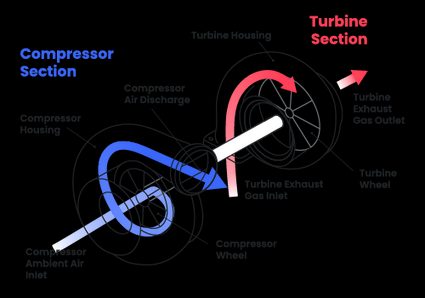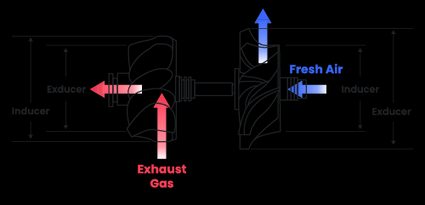Turbo Size Calculator
Table of contents
What is a turbo?Can you turbocharge any engine?How to calculate turbo sizeHow to use our turbo size calculatorFAQsIf you want to turbocharge your petrol engine, our turbo size calculator is the perfect tool for the job! Input your desired amount of horsepower and the engine capacity to find the turbocharger size for your machine. It's the first step to creating the powerful project car of your dreams!
Read the article below to learn more about turbocharging a petrol engine, what a turbo is, and how to calculate turbo size for your vehicle.
What is a turbo?
A turbocharger, or simply a turbo, is like a power booster for your car's engine. When someone asks you, "What is a turbo?", you can tell them that it's like a special fan that helps the engine breathe better.
Unlike naturally aspirated (NA) engines, which breathe air directly from the atmosphere, a turbo uses exhaust gases to spin a turbine. This turbine is connected to a compressor, which squeezes and pushes more air into the engine. More air means the engine can burn more fuel, leading to a significant increase in power.
Unlike a supercharger, which is belt-driven, a turbocharger uses the engine's own exhaust gases to operate, making it more efficient in boosting power without needing extra energy from the engine.
So, in simple terms, a turbo gives your car more power by using what the engine already produces — its exhaust! 💪

Take a look at this image of a turbocharger. As you can see, it's made up of two sections: the turbine section and the compressor section. Sizes calculated by our tool are based on the compressor's inducer diameters, a standard method for labeling turbo sizes. The image below visualizes both inducers and exducers.

Can you turbocharge any engine?
Turbocharging an engine is a popular way to increase its power, and our calculator focuses on petrol, naturally aspirated engines for this purpose. But how do you add a turbo, and can you turbocharge any engine? The answer is a bit more complex.
Many engines, especially older ones, can be turbocharged if they aren't already equipped with a turbo. It's more common to find turbochargers in diesel engines, as they're almost a standard feature there. However, many petrol cars are naturally aspirated, meaning they don't have a turbo, supercharger, or any other forced induction device.
How many hp does a turbo add? It's also complex because to turbocharge a naturally aspirated petrol engine, you need more than just the turbocharger itself. There are essential modifications and additions required. For starters, you might need to upgrade the engine's internals to handle the extra pressure and power. This includes stronger pistons, rods, and sometimes even the crankshaft. The fuel system may also need an upgrade to supply more fuel to match the increased air from the turbo. Check our fuel consumption calculator⛽ to calculate the difference!
Moreover, with the extra power comes the need for other modifications. For example, wider tires may be necessary to handle the increased horsepower and ensure better traction. Our tire size calculator might be the perfect tool for the job!
In short, for a naturally aspirated petrol engine to qualify for a turbocharger, it needs to meet these requirements:
-
Strong engine parts — The engine must be tough enough to handle the extra power without breaking;
-
Good cooling — Turbocharged engines get hotter, so a better cooling system is needed;
-
More fuel supply — The engine will need more fuel to go with the extra air from the turbo; and
-
Space for the turbo — Turbocharging a petrol engine takes space. There has to be enough room in the engine bay.
⚠️ Remember that our calculator is intended for naturally aspirated petrol-powered engines! Now we've answered how many hp does a turbo add and how to add a tubo, the next question is how does it influence your car's performance? Use our horsepower calculator to compare quarter mile time for your vehicle before and after modifications!
How to calculate turbo size
Figuring out the right size for a turbocharger isn't simple, but we've got you covered. Our calculator simplifies this complex task based on industry standards, particularly the guidelines from Garrett — one of the top turbocharger manufacturers renowned for their quality and expertise. boil it down to two key factors: the engine's capacity and your desired horsepower output. This means you can choose the correct turbo size just by knowing your engine's size and how much power you want it to produce.
Not sure about the capacity of your engine? Our engine displacement calculator might help you with that.
Suppose you want to check the sizes for yourself. In that case, you'd have to find a specification for each turbine you're interested in, check its compressor's inducer size, the engine capacity, and the potential power output it was designed for, or you can just use our turbo size calculator to check the results in seconds! Remember, when talking about turbo sizes, terms like "38mm" refer to the compressor's inducer diameter, measured in millimeters.
How to use our turbo size calculator
Our turbo size calculator is user-friendly and straightforward. Input just two values to see the results:
-
Engine capacity — Enter the capacity of your engine in cubic centimeters (cc) or liters (l). Remember, your engine should be petrol-powered and naturally aspirated.
-
Desired power — Input the amount of power you want your engine to produce in kilowatts (kW) or horsepower (hp). Dream big, but be realistic!
-
Results — The ideal turbo size for your engine will be listed below. This size is the compressor's inducer diameter. We'll even suggest a specific turbo model you can buy.
For example, suppose you're driving a 1999 BMW 3er with a 2494cc naturally aspirated engine, and you want it to produce 500 horsepower after turbocharging. In that case, our calculator will inform you that the best turbo size for the job is a 48mm one!
If you enter a very low horsepower, the tool will tell you that a turbo isn't necessary. And if the horsepower you desire is too high, you'll be informed that it's physically unfeasible. Our calculator makes finding the right turbo size easy and informative!
What size turbo do I need?
Choosing the right turbo size depends on:
-
Engine size — bigger engines might need larger turbos;
-
Additional modifications — preparing the engine's internals is required for bigger turbos;
-
Desired power — more power requires a bigger turbo; and
-
Vehicle use — racing/project cars usually require bigger turbos than daily drivers.
Each factor affects your choice.
How do I calculate turbo size?
To calculate turbo size, follow these steps:
-
Determine engine capacity — For instance, if your engine is 2700cc.
-
Set desired horsepower — Say, you aim for 400 horsepower.
-
Compare turbo sizes — Find a turbo size that was designed for your engine size and desired power output, or use a turbo size calculator.
Based on these inputs, for a 2700cc engine and 400 horsepower goal, you'd need approximately a 48mm turbo.
What size is a stock 5.9 Cummins turbo?
The stock turbo size for a 5.9 Cummins, commonly found in Dodge Ram trucks, typically features a Holset HY35W or HX35W turbocharger. These models have a compressor wheel with an inducer diameter of around 56mm. However, specific sizes can vary slightly depending on the year and model of the vehicle.
Can I turbocharge and supercharge a car?
No, you can either turbocharge or supercharge a car, but you cannot do both simultaneously. Each method forces more air into the engine differently — turbocharging uses exhaust gases, while supercharging is driven mechanically. Combining them would be complex, potentially inefficient, and could lead to mechanical conflicts.
